The Catch Heard ‘Round the World:
An interview with Art Weston

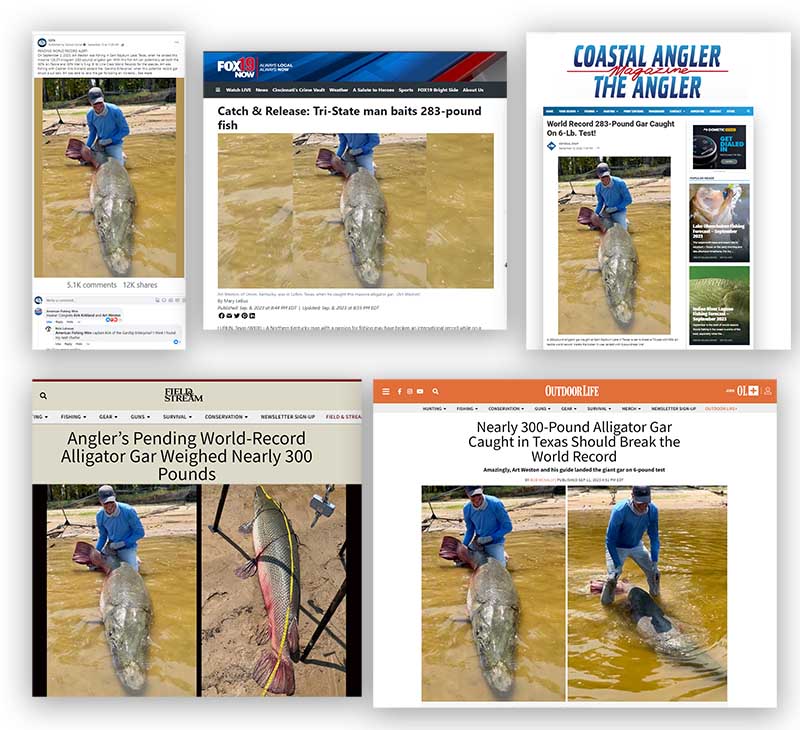
If you follow fishing news or social media pages, you might be one of 924 million people who saw the viral photo of a 283-pound alligator gar caught on 6-pound test line. There’s more to this extraordinary catch than meets the eye, and today we’re sitting down with the angler behind the catch, analytics expert Art Weston.
Art Weston’s love of fishing was ignited during his childhood days in Illinois, where he grew up fishing with his father and brothers. Professionally, he's been deeply involved in analytics, primarily within the financial services sector, and currently focuses on Artificial Intelligence. With an impressive count of more than 50 current and pending IGFA World Records, it should come as no surprise that Art brings the same analytical approach from his career into his hobbies, relying on strategic planning and analytics data to reach his goals.
During a recent eight-day fishing expedition on Sam Rayburn Lake in Texas, Weston accomplished something extraordinary. Onboard IGFA Captain Kirk Kirkland's boat Garship Enterprise, he managed to reel in a massive 283-pound alligator gar, measuring over 8 feet in length and 4 feet in girth, using a mere 6-pound test line.
To put this achievement in context, the current All-Tackle world record for this fish stands at 279 pounds, a record that has remained unbroken since December 2, 1951, when Bill Valverde set it in Rio Grande, Texas. Weston's catch has the potential to break multiple IGFA World Records, a testament to his unwavering dedication to the sport of fishing. We recently sat down with Art for a technical deep-dive on all things analytics, fishing, and IGFA World Records.
How did you first learn about or become involved with the IGFA and the pursuit of world records?
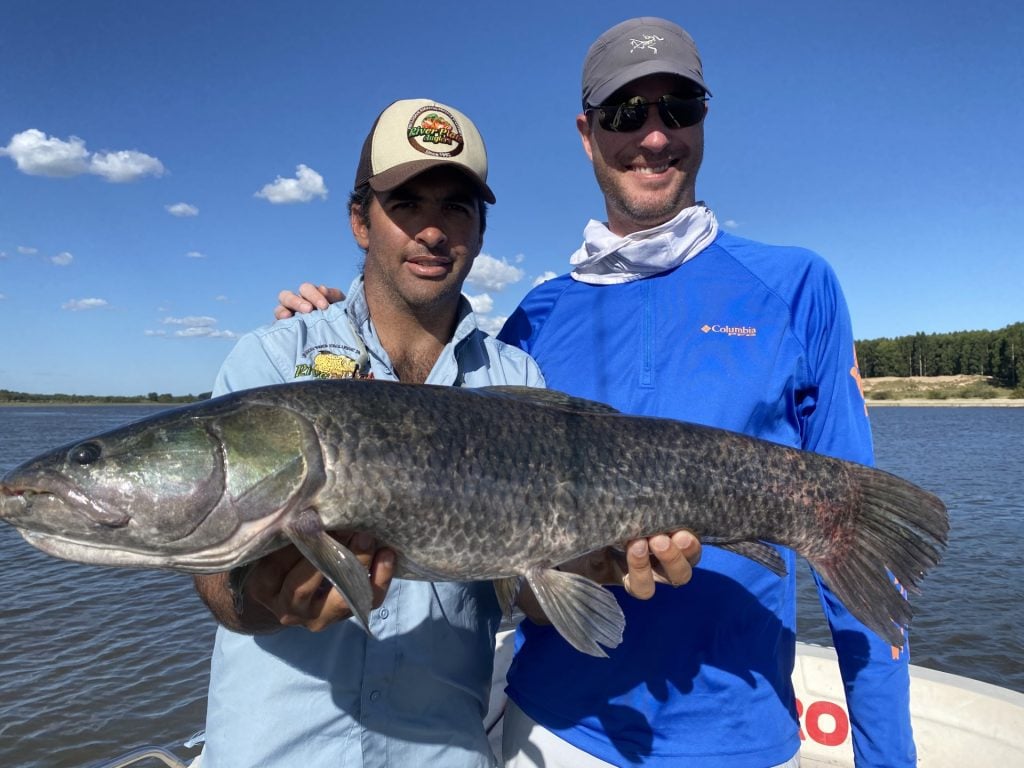
I discovered the IGFA when I met Patrick Brown, the IGFA Representative in Uruguay, while fishing for golden dorado. Patrick hosted our trip and introduced me to the IGFA. He even assisted me in achieving one of my initial records, specifically the dorado length record.
My first Line Class record was one of the most extraordinary and challenging experiences in my fishing career. In November 2017, I hooked into a formidable fish in the Jatapu River, a pool with depths of up to 75 feet. I was using 2-pound Ande Tournament line, hoping to catch a payara, as we knew they inhabited that pool. We also targeted 100+ pound piraiba and other catfish in the same area. My fishing partner, Andrew Hopkins, endured a grueling 4.5-hour battle until dusk, when I finally brought the 9 lb 8 oz payara to the surface. This marked my initial Line Class record.
Since then, I've decided not to involve other anglers in my record hunts, as it wouldn't be fair to subject them to such demanding challenges. Currently, I hold 29 current and approved Line Class records, 9 pending Line Class records, and have two more to submit from my recent trip to Texas.
Looking at your list of records on the IGFA World Record Database, all your records are for freshwater species. Can you talk about why that is?
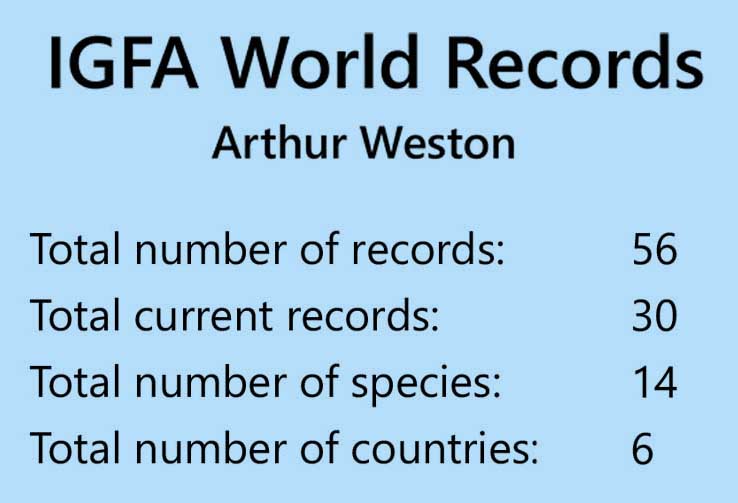 I used to exclusively fish in saltwater with my father and siblings for years, exploring places like Key West and Cabo San Lucas. However, my perspective shifted when I joined a trip to the Amazon with my father and friends. Freshwater river fishing immediately captivated me. I do plan to return to saltwater fishing at some point, and I feel that there are numerous record opportunities in both environments.
I used to exclusively fish in saltwater with my father and siblings for years, exploring places like Key West and Cabo San Lucas. However, my perspective shifted when I joined a trip to the Amazon with my father and friends. Freshwater river fishing immediately captivated me. I do plan to return to saltwater fishing at some point, and I feel that there are numerous record opportunities in both environments.
It’s no secret that you are an analytical person, from your career to your fishing. Could you elaborate on how your analytical background aids you in pursuing world records?
Throughout my career, I've been deeply involved in analytics, primarily within the financial services sector, with a current focus on Artificial Intelligence at Fifth Third Bank. I tend to approach my hobbies with the same analytical mindset I apply to my work. This involves striving for exceptional outcomes and utilizing strategic planning and analytics to achieve them.
I've been told that I possess an exceptional determination to fine-tune and optimize tactics, and fishing is no exception. When I became serious about fishing, especially in the context of record hunting, I realized that success depended more on meticulous planning and preparedness than mere luck. I relish the challenge of setting records, and even when I encounter failures (which have been numerous), I find satisfaction in analyzing what went wrong and devising solutions to address those shortcomings.
Could you describe the level of planning and analysis that you apply to pursuing an IGFA World Record?
Weston has allocated a section of his basement, affectionately dubbed his "angling laboratory," for the storage of all his fishing gear and testing equipment, which includes digital force gauges.
It's not uncommon for me to plan extensively for three to six months before a specific fishing trip, and I typically embark on three to four major fishing trips each year. I've dedicated space in my basement, which I fondly call my "fishing lab," to store all my fishing equipment and testing machinery, including digital force gauges. In some cases, I've had to personally design and collaborate with manufacturers to produce specialized equipment tailored to a specific fishery and tactic. For example, I've developed innovative ultra-heavy spinnerbaits for golden dorado and worked with skilled woodworkers to create peacock bass wood choppers. Additionally, I've designed my own heavy travel rods to confidently tackle remote locations.

How have you refined your angling techniques for targeting large fish on light tackle?
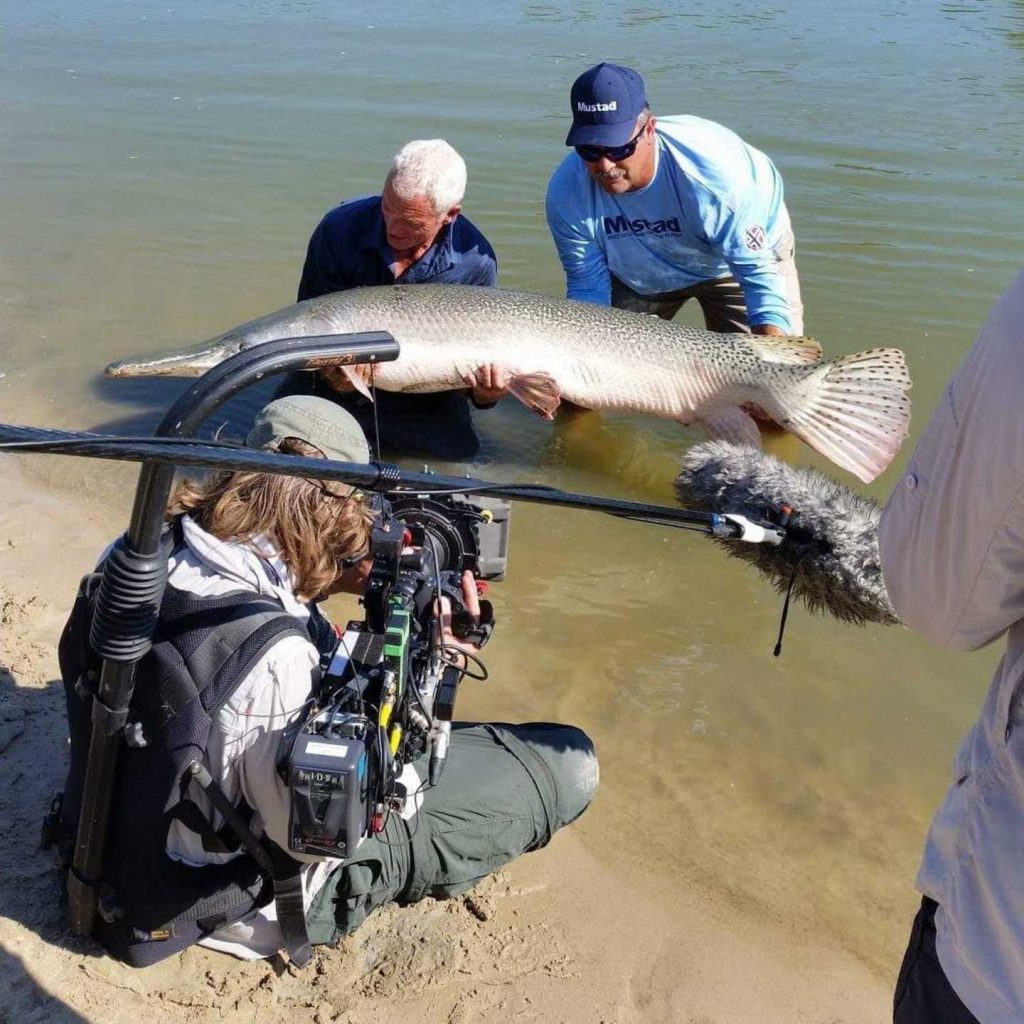
I distinctly recall watching a documentary on alligator gar and becoming intrigued because I hadn't heard much about them inhabiting the Midwest. Their size, as a species within the continental US, fascinated me, not to mention my affinity for river fishing. After conducting some research, I learned that IGFA Captain Kirk Kirkland was renowned as one of the best guides for gar fishing. When I inquired about his willingness to accommodate my desire to fish for records, he promptly informed me that he was an accomplished IGFA Captain and world record guide. I booked my first trip with him in 2020, and we've shared numerous fishing adventures since.
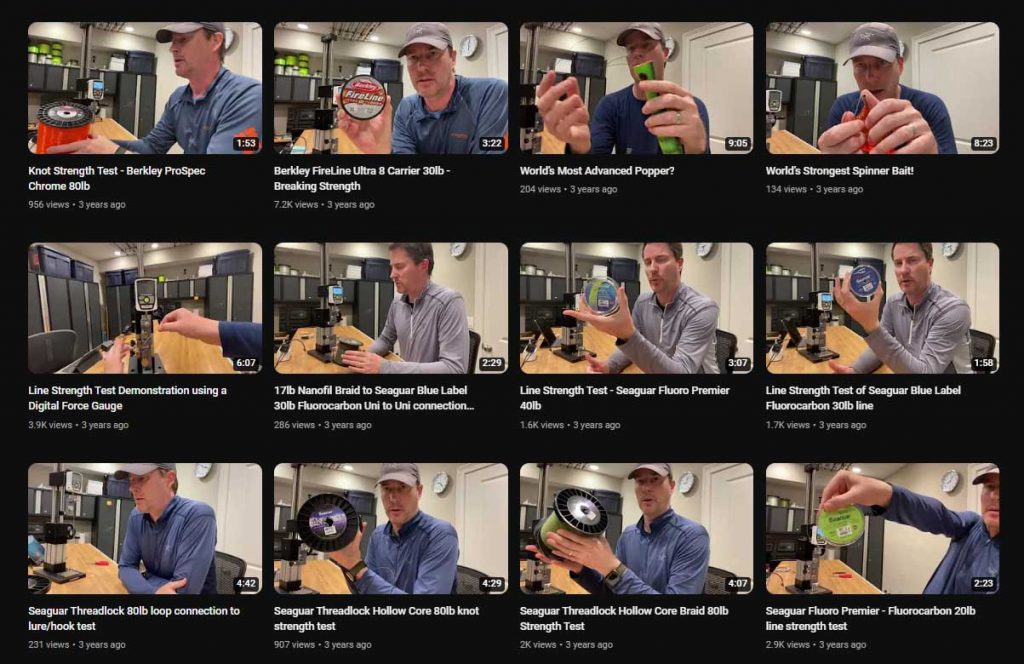
Most of my tactics for light line golden dorado fishing, another favorite of mine, involve considering specific factors. Firstly, it's crucial to maximize the allowable leader length, as a fish's tail can easily snap light line. Second, selecting the appropriate “J” or circle hook is essential, taking into account the fish's mouth structure and feeding habits. In contrast to golden dorado, where small circle hooks work well on light line without requiring a hook-set, alligator gar don't seem to respond favorably to curved-tipped hooks. I've also found that up-eye hooks, when snelled or rigged correctly, lead to a better hook-up rate for all fish species. Interestingly, smaller hooks, which are effective for dorado, don't fare as well for gar due to the size of the cut-bait used. The answer is to opt for larger hooks, giving the fish more time to swallow the bait before applying pressure. After extensive experimentation, I settled on using Gamakatsu Big River Bait hooks up to 8/0, paired with AFW brand 175-pound 49-strand steel leader material and a size 5 AFW dual ball bearing swivel.
Regarding line selection, for the lightest line classes, braid options aren't easily or readily available, as no manufacturer offers IGFA-class ultralight braided line. Thus, the choice comes down to monofilament, copolymer, or fluorocarbon lines. While most modern lines focus on being the thinnest and strongest, which is ideal for most applications, super light line benefits more from increased abrasion resistance, even if it results in a thicker line diameter. Momoi Hi-Catch IGFA monofilament, with its greater diameter, remains my top choice for light line, as it significantly boosts abrasion resistance, especially in situations where spool capacity or casting isn't a concern.
When it comes to knots, I exclusively use the Palomar knot on light line, as it's one of the few knots that won't slip or unravel under pressure. For heavier mono lines, I transition to using aluminum crimps, typically at a rate of one crimp per 20 pounds of test. My digital force gauge has allowed me to extensively test knot and crimp connection strengths and reliability.
For larger line classes where line capacity and joining concerns come into play, I prefer using Dacron braid. Although Dacron is an older line technology and not popular for most anglers due to its greater thickness, it excels in terms of abrasion resistance, particularly compared to spectra-based braids with smaller diameters. Woodstock's "The Angler's Connection" manufactures an IGFA-class Dacron line that serves as a reliable choice for record hunting and is relatively cost-effective compared to spectra varieties. It's essential to note that braid manufacturers tend to underestimate their lines' breaking strength, mainly because braided lines break at about 60% of the main-line strength at the knot. However, the IGFA tests lines along the main-line, not at the knot, so using braid for line-class records requires careful consideration unless the line possesses an IGFA rating or you've submitted a sample to the IGFA for accurate measurement. Additionally, be cautious with braids exceeding 80-pounds in stated strength, as many of them surpass the IGFA all-tackle maximum breaking strength of 132.27-pounds.
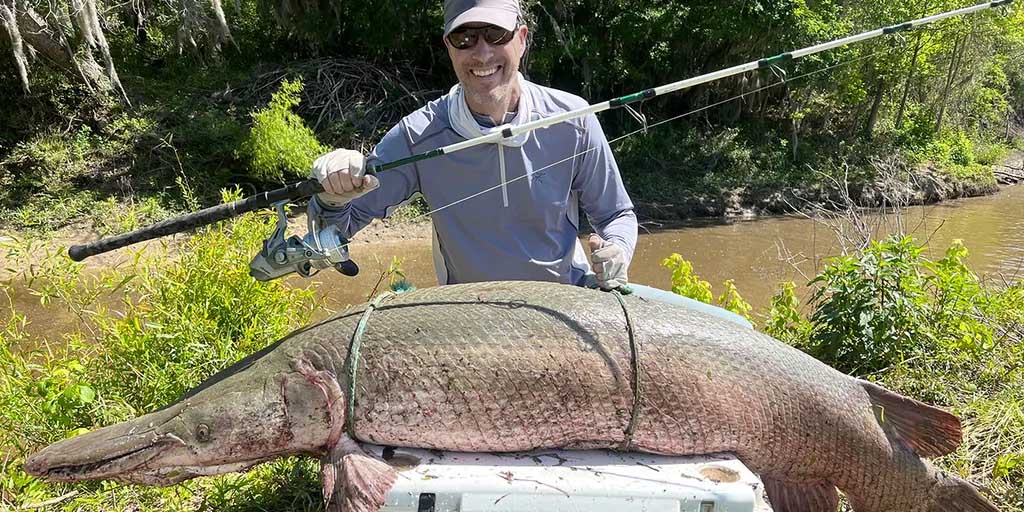
Spinning gear is paramount for gar fishing when using cut-bait, especially with the inclusion of a bait-runner feature. Alligator gar often pick up bait and hold it in their mouths without swallowing immediately. If you attempt to set the hook or apply pressure prematurely, the gar might simply open their mouths and release the bait. Boat fishing becomes advantageous in this context, as it allows you to follow the gar before they decide to consume the bait and prevents them from spooling you.
Finally, regarding the rod, for light line and boat-based bait fishing, I prefer using rods designed for vertical/speed jigging. These rods offer ample flex to reduce stress on the line. My favorites are Goofish's Ares Solid Nano blank spinning rods.
Aside from alligator gar, another beloved species of mine is the golden dorado. Although there are numerous destinations to target them throughout South America, there's only one place where you can consistently catch them at their largest sizes in substantial quantities – below the Salto Grande dam, which separates Argentina and Uruguay. Only two operators, LaZona Lodge and River Plate, offer bookings in the restricted area just below the dam. I've fished at both operations and highly recommend anglers to explore this remarkable fishery.

In my opinion, golden dorado rank as the most impressive freshwater river fish globally, though I acknowledge there are other species like snakehead I have yet to target. Compared to peacock bass, for instance (I've landed a 26-pound fish, which was the recently retired IGFA length record), an equivalently sized dorado puts up a more intense, extended fight, likely involving numerous jumps. When you hook a 40+ pound dorado, it offers a unique challenge, as they can easily break heavy lines, destroy lures, snap rods, and regularly fling back chewed-up lures.
You incorporate a specific leader setup when targeting these big fish on light tackle. Can you please share more about your setup and how it has helped you in the pursuit of records?
Using a lengthy leader is critical when you're fishing with light line, and it isn't solely about protecting against a gar's mouth. During a long fight, gar tend to roll multiple times, which includes rolling over the line. Their scales are incredibly sharp, and light line won't withstand contact with those scales. Even the gar's tail can whip and snap light line. Thus, adhering to the IGFA's maximum leader length in freshwater of 72” (including the hook and swivel) is essential. I usually make my leaders slightly shorter to ensure compliance with IGFA regulations. The longer leader also assists the guide in handling the fish when it's alongside the boat, preventing them from touching the light line.
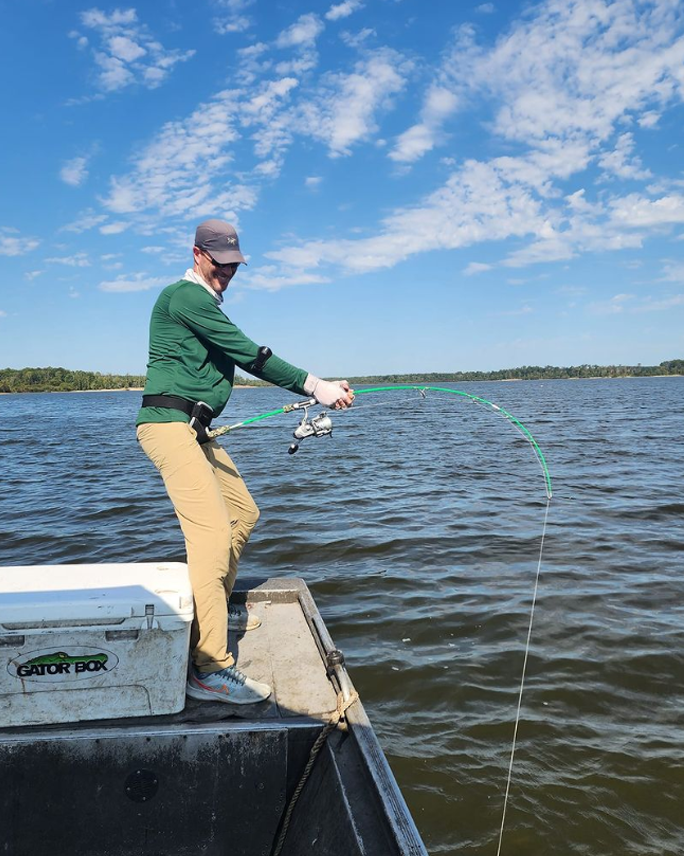 Can you explain why you chose to fight the fish from the boat rather than from shore and the role of having a well-versed IGFA guide that is onboard with the strategy?
Can you explain why you chose to fight the fish from the boat rather than from shore and the role of having a well-versed IGFA guide that is onboard with the strategy?
Shore fishing for gar can be thrilling but isn't the most strategic approach when you're targeting records. Additionally, gar often carry bait in their mouths for extended periods before swallowing it, potentially spooling you if you're shore fishing. With a boat, you can follow the gar while they carry the bait, which gives you more confidence to apply pressure when needed.
Being in closer proximity to the gar also helps avoid line snagging, a common occurrence in the rivers and lakes inhabited by large gar.
The primary challenge when boat fishing for gar is the guide's skill, particularly during prolonged fights. Captain Kirk Kirkland is an exceptional boat captain and gar guide. We work seamlessly together, ensuring the boat is consistently positioned advantageously to land the fish. This is especially crucial with large fish on light line, as they often surface to gulp air every 20 minutes or so, sometimes staying submerged for extended periods. While not all gar are boat-friendly, some will surface right next to the properly positioned boat, providing the guide with an opportunity to land them.
Your initial goal was to surpass the existing 123 lb 9oz record. How did you adapt your approach when you unexpectedly hooked a much larger fish?
We had absolutely no intention of targeting an All-Tackle record when we were using the 6-pound setup. Our goal was to have a shot at the 123-pound 9-ounce gar, which we believed was attainable since we were fishing in a section of Sam Rayburn Lake with a sandy bottom devoid of heavy snags. Even with just four pounds of drag (the approximate drag setting with 6-pound test), you can apply enough pressure to land a fish of that size in less than an hour. When fishing with light line, you almost hope for a manageable fish in terms of size to increase your chances of landing it. The very first fish that took the bait happened to be the colossal 283-pound one. I recall thinking, upon seeing it roll, that it was a record contender, maybe even "too big" to land. Once it was confirmed that we were dealing with a record catch, and a substantial one at that, we knew we were in for an extensive battle. Kirk and I had previously experienced two other record gar fights that lasted over two hours, landing one and losing the other. To handle long fights more effectively, I've learned to wear a small fighting belt to rest the rod's butt when my 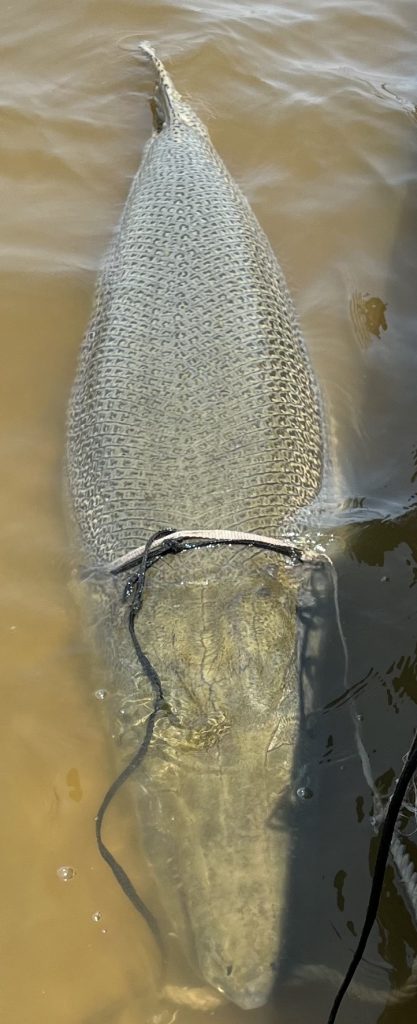 hands and arms become fatigued. I've also developed a technique for holding the rod's butt under my forearm when not using the belt, which aids in managing the extended fight comfortably.
hands and arms become fatigued. I've also developed a technique for holding the rod's butt under my forearm when not using the belt, which aids in managing the extended fight comfortably.
You mentioned that alligator gar often come to the surface during long fights. Why is this behavior significant for capturing the fish, and how does it assist in landing the fish?
This behavior is the single most critical factor enabling the landing of these large fish when using light line. A skilled guide like Kirk can position the boat close to the gar when they surface, providing an opportunity to land them. They don't always cooperate and may surface too far from the boat to be landed. Additionally, some gar don't surface as frequently as others and may remain motionless on the bottom for over half an hour. With light line, patience is essential, as you can't force the fight due to limited drag settings.
Can you clarify the conditions under which Captain Kirk legally lands the fish per IGFA rules and why the behavior of a gar coming to the surface is a key factor in this process?
At the side of the boat, the guide can legally land the fish by grabbing the leader (in my case, the 70” 175-pound leader) and securing the fish using various methods. If the fish is small enough, Kirk's preferred method is using a Boga Grip on the mouth. For larger fish, Kirk has a wide net that he has used for me in the past. However, for giants, Kirk can hold the steel leader in one hand and use the other to slide a loop of a lasso over the gar's head (the lasso passes over the leader) and cinch it tight behind the pectoral fins.
How would you compare this gar fishing experience to other fishing adventures you've had in the past in terms of difficulty and excitement?
After numerous fishing trips to South America, I've developed a preference for river fishing at this stage of my angling career. Incorporating gar fishing locally provides a similar experience and offers plenty of challenges and excitement. I don't know if I'll ever experience the same level of astonishment as when the 283-pound gar appeared by the side of the boat, allowing us to get a close look at her. I remember my eyes widening in amazement!
Do you have any plans or aspirations for future fishing trips or species records you'd like to pursue?
I already have plans to return to Texas in April 2024 and golden dorado fishing in September 2024. However, I've become intrigued by the idea of record hunting for musky in Wisconsin and might plan a trip for that in 2024.
